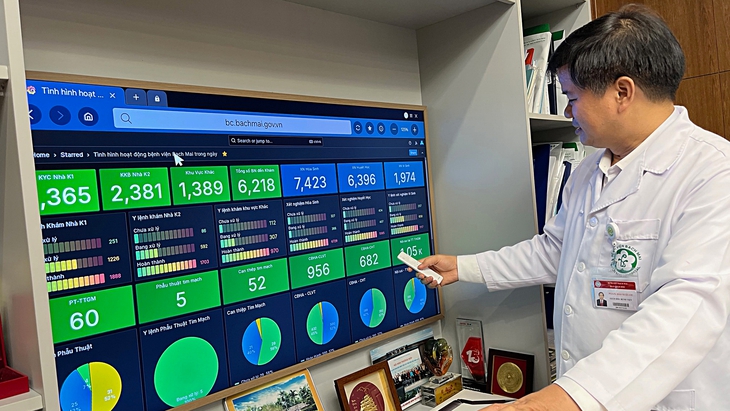
Arthroscopic surgery to treat sports injuries. Currently, over 160 hospitals have applied electronic medical records - Photo: BVCC
Will adding IT application costs to the price increase hospital fees?
Speed up the completion of electronic medical records
Since March 2019, the Ministry of Health has implemented electronic medical records for medical facilities. It is expected that when implemented, this regulation will connect test results between hospitals, patients will not have to be tested again when transferring hospitals, thereby reducing the time of both patients and doctors, and reducing medical costs.
However, after more than 6 years of implementation, as of May 4, only 169 public and private medical facilities nationwide have announced the successful implementation of electronic medical records. The Ministry of Health has requested that hospitals nationwide complete this task by September 30.
According to Deputy Minister of Health Nguyen Tri Thuc, the implementation of electronic medical records must ensure substance, bring specific effectiveness, improve productivity and quality of medical examination and treatment, and bring practical benefits to people and medical facilities.
Immediately after the Ministry of Health issued a plan to urge hospitals to implement electronic medical records, within 1 month (from April to May), 16 more medical facilities completed this work.
Meanwhile, according to statistics, there are currently nearly 1,650 hospitals nationwide (including about 380 private hospitals), the number of hospitals that have not completed electronic medical records is very large.
One of the reasons for the slow progress in implementing electronic medical records is the difficulty in resources and funding.
According to the head of the information technology department at a hospital in Hanoi, in order to effectively operate examination and treatment activities, the hospital has recently spent a large amount of money to invest in a synchronous system of server equipment and computer systems.
In particular, software applications such as hospital management (HIS), picture archiving systems (PACS), information security programs, data, network security... To use these software, hospitals must pay monthly rental fees to service providers at a not small cost.
More costs, will hospital fees increase?
According to the latest plan of the Ministry of Health, it is expected to include the cost structure of information technology application in the price of medical examination and treatment services. The Ministry of Health assigned the Department of Planning and Finance and requested completion by June 2025.
According to the Law on Medical Examination and Treatment, from 2024, the total cost of medical examination and treatment services will include 4 components: labor costs; direct costs for patients (blood, medicine, infusion); depreciation costs of medical equipment, fixed assets and management costs. Most hospitals have only calculated labor costs and direct costs, the remaining two parts have not been included in the price.
Information technology costs are classified as management costs. Including this item in the price of medical examination and treatment services aims to help hospitals have resources to invest in technological equipment, according to Mr. Dao Xuan Co, director of Bach Mai Hospital. In many countries, this item is calculated at 3% of the hospital's total revenue, thereby solving the resource problem that has prevented many hospitals from implementing electronic medical records as planned.
Speaking with Tuoi Tre, Mr. Nguyen Van Thuong, director of Duc Giang General Hospital, said that Vietnam has just started investing, so the initial cost may fluctuate around 10% of total revenue and then gradually decrease.
"Including information technology fees into the price will increase hospital fees, but in the long run it will help save some costs. The most noticeable of which is that the cost of printing films when taking X-rays and PET-CT will no longer be needed, instead, investing in PACS software (a system for storing and transmitting images in medicine) will only be 50-70% of the cost of buying and printing films. That is not to mention the effectiveness in protecting the environment.
In addition, when applying information technology, there will be a complete medical data system on common diseases, which age group has which disease, male or female, prescription management... from there, it will be effective in treating and preventing diseases, saving unnecessary prescriptions, saving treatment costs," Mr. Thuong analyzed.
At Bach Mai Hospital, Mr. Co said that just not printing films or paperwork has helped Bach Mai Hospital save 100 billion/year, this money continues to be invested in upgrading the hospital's information technology system and digital transformation.
Mr. Co also said that thanks to electronic medical records, the construction of a national medical data warehouse is of great significance, not only supporting policy making, scientific research, and human resource training, but also helping to optimize drug and equipment planning. When the interconnected system is complete, tests and films can be shared between hospitals, significantly reducing costs for patients.
An information technology expert from the Ministry of Health said that adding the cost of applying information technology to the price structure of medical examination and treatment will of course increase hospital fees.
"The increase will need to be specifically calculated based on the standard cost of applying technology to medical examination and treatment. This also depends on the scale of the hospital. The cost per bed for a special-class hospital will be different from the cost of a district-level hospital," the expert said.
He also said that in 2017, the Ministry of Health had a draft on this cost norm but now it needs to be rebuilt. "Although the increase is not too much, if applied to all technical services, it will still be an additional cost, more or less it will affect the people," the expert said.
Experts also said that when hospital fees include information technology costs, it means that hospital fees will increase. However, health insurance participants will also have their costs covered by health insurance, instead of having to pay for infrastructure depreciation and hospital management as they do now. Properly calculating hospital fees will gradually reduce out-of-pocket expenses for people.
Hospital fees do not increase but may decrease, why?
According to Mr. Dao Xuan Co, if you spend 1 dong on information technology, you will save 10 dong. For example, at Bach Mai, implementing electronic medical records has saved costs such as printing films, ink and printing paper, film storage (renting a normal warehouse alone is 7 billion/year), these expenses are over 100 billion/year.
In addition, the data connection between hospitals will reduce the cost of re-examination and testing, and in the long term will standardize the quality of testing and imaging between medical levels, improving the quality of medical examination and treatment.
Another important benefit is managing health data and disease models, thereby orienting disease prevention strategies, investing in equipment, purchasing drugs and vaccines. These data are all very important.
"In my opinion, information technology will save a lot of costs, so the initial investment may cost a bit of money, but in the long run it will save a lot of other expenses. Therefore, hospital fees may not increase but may even decrease, if implemented drastically," said Mr. Co.
Include in hospital investment costs
The above technology expert said that in the future, the cost of applying information technology may be included in the investment costs of hospitals.
Currently, hospitals use their revenue to reinvest in medical equipment, machinery, and infrastructure to improve quality... From there, they may be required to use that cost to reinvest in information technology and avoid affecting the price of medical services for the people.

Thanks to information technology, the board of directors of Bach Mai Hospital now knows specifically how many patients are being examined, treated, and what services are being used, whether the hospital is open or congested, so that timely solutions can be found - Photo: HONG HA
"Previously, we did not have regulations on how much of the total revenue hospitals had to set aside to reinvest in information technology applications. If we set regulations on the percentage of revenue that hospitals were required to set aside to reinvest in information technology, it would help hospitals promote the development of this field, without causing additional burdens for the people.
According to the cost norms for applying information technology in the circular guiding the set of criteria for applying information technology at medical examination and treatment facilities, the investment cost for applying information technology at a grade I hospital ranges from 10.5 billion VND to nearly 40 billion VND (from level 1 to level 7).
This cost accounts for 0.57% to 2.1% of the total revenue of medical facilities. The investment cost level depends on the number of medical examinations and treatments, the scale of the hospital...
Source: https://tuoitre.vn/them-phi-cong-nghe-thong-tin-vien-phi-co-tang-20250504224528801.htm




![[Photo] Solemn opening of the 9th Session, 15th National Assembly](https://vphoto.vietnam.vn/thumb/1200x675/vietnam/resource/IMAGE/2025/5/5/ad3b9de4debc46efb4a0e04db0295ad8)

![[Photo] National Assembly delegates visit President Ho Chi Minh's Mausoleum](https://vphoto.vietnam.vn/thumb/1200x675/vietnam/resource/IMAGE/2025/5/5/9c1b8b0a0c264b84a43b60d30df48f75)



![[Video] Ministry of Health requests Nam Dinh Department of Health to review emergency admission and treatment procedures](https://vphoto.vietnam.vn/thumb/402x226/vietnam/resource/IMAGE/2025/5/5/95613998c31e4dbf946f326b0df19414)













![[Photo] General Secretary To Lam receives Sri Lankan President Anura Kumara Dissanayaka](https://vphoto.vietnam.vn/thumb/1200x675/vietnam/resource/IMAGE/2025/5/4/75feee4ea0c14825819a8b7ad25518d8)
![[Photo] Vietnam shines at Paris International Fair 2025 with cultural and culinary colors](https://vphoto.vietnam.vn/thumb/1200x675/vietnam/resource/IMAGE/2025/5/4/74b16c2a197a42eb97597414009d4eb8)

![[Photo] Bus station begins to get crowded welcoming people returning to the capital after 5 days of holiday](https://vphoto.vietnam.vn/thumb/1200x675/vietnam/resource/IMAGE/2025/5/4/c3b37b336a0a450a983a0b09188c2fe6)
































































Comment (0)